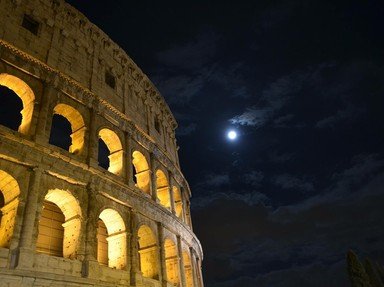Quiz Answer Key and Fun Facts
1. Let us start our tour of Rome's hills with a stunning nighttime view of Piazza del Campidoglio, the square at the heart of the Capitoline Hill. What great Renaissance artist - many of whose masterpieces can be seen around Rome and the Vatican - designed this scenic piazza?
2. Overlooking the Forum, the Palatine Hill contains some of Rome's oldest buildings, as well as several imperial residences. Which emperor - the younger brother of the ruler who completed the Colosseum - ordered the construction of the huge palace whose ruins you can see in the photo?
3. The Quirinal Hill hosts the sprawling Palazzo del Quirinale, home to the President of the Italian Republic. What legendary twin brothers, known as the "sons of Zeus", are represented in the two statues adorning the fountain in the palace square?
4. The smallest of the seven hills, the Viminal Hill was mostly a middle-class residential area in Roman times. What kind of trees, usually growing near water and used to make baskets and furniture, is the hill named after?
5. With its three peaks, the Esquiline Hill boasts a wealth of interesting monuments from various ages. What is the name of the large church - one of Rome's four major papal basilicas - that stands on the top of the hill?
6. Not surprisingly, the beautiful Caelian Hill used to be a fashionable residential area. Now it mostly hosts green spaces and a number of the city's most interesting ancient churches. The one shown in the photo, Santo Stefano Rotondo, is the national church of which landlocked central European country?
7. The southernmost of the seven hills, the Aventine Hill dominates the Tiber River, allowing gorgeous views of the city centre and the Vatican. The photo depicts one of the hill's most impressive sights, the magnificent 18th-century villa that hosts one of the institutional seats of which famous Catholic military order?
8. As the quiz title implies, in Rome you will find more than just its proverbial seven hills. One of them is the Pincian Hill. The photo shows its renowned panoramic terrace, standing directly above which of the city's famous squares - with its slightly revolutionary-sounding name?
9. The second-highest of Rome's many hills, the Janiculum lies outside the boundaries of the ancient city, on the west bank of the Tiber. Indeed, it overlooks what very picturesque neighbourhood - packed with cafés and restaurants - whose name implies that it is located "beyond the Tiber"?
10. Last but not least, we come to Rome's highest hill, Monte Mario, located northwest of the city centre. The photo shows one of the few buildings found on the hill's eastern slope, facing the Tiber - a beautiful Renaissance villa that goes by what rather courteous name?
Source: Author
LadyNym
This quiz was reviewed by FunTrivia editor
agony before going online.
Any errors found in FunTrivia content are routinely corrected through our feedback system.
